Lebanese Stuffed Grape Leaves
May 24, 2012, Updated Jan 31, 2024
This post may contain affiliate links. Please read our disclosure policy.
Lebanese Stuffed Grape Leaves (warak enab) are a Mediterranean favorite! They taste the very best homemade. My recipe includes rice, meat, and lots of lemon to make the most tender, flavorful grape leave rolls.
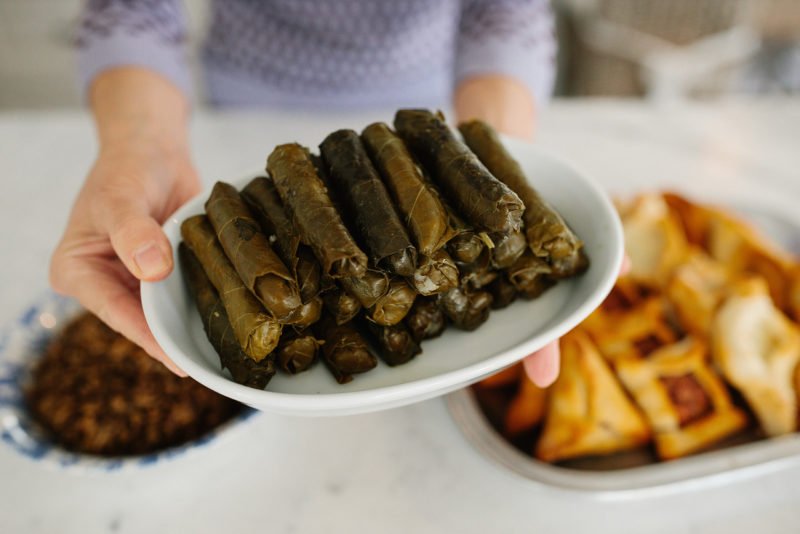
There may be no more beloved, well known Middle Eastern dish than stuffed grape leaves. This favorite recipe among my Lebanese recipes makes a large pot of lovingly rolled grape leaves, a tradition we turn to for every major family feast.
My husband Dan loves to tease me that his Shaheen clan reigns with the Lebanese grape leaves experts. I can’t deny that the grape leaves they make are luscious. Yet my Aunt Hilda was also a grape leaves expert, and I learned plenty from her growing up…. She arrived for every feast with a huge pot of her melt-in-your-mouth grape leaves. I cherish making them with her at her kitchen table, talking about all of the family and whatever party was about to take place. It’s a lot of fun making them with people you love, a labor of love that delights in a gathering.
Read my story about tasting grape leaves from our family village in Lebanon here!
Lebanese stuffed grape leaves taste delicious with meat and rice stuffing as in my method here, as well as vegetarian versions. Try my vegetarian stuffed grape leaves recipe here. The difference for the vegetarian version is the filling, which is a rice mixture made with fresh parsley and other fresh herbs. Both ways are packed with savory flavor, not to be missed.
Find success with this special, traditional Lebanese recipe for grape leaves following my tried and true instructions.
Table of Contents
- Ingredients for Lebanese Stuffed Grape Leaves
- How do you make Lebanese Grape Leave Rolls?
- Important Tips for Making the Best Lebanese Grape Leave Rolls.
- Can I make them ahead of time?
- Are stuffed grape leaves really Greek or Lebanese?
- Frequently Asked Questions.
- Make Ahead: how to store grape leaves
- What do you serve with Lebanese Stuffed Grape Leaves?
- More Lebanese Recipes to Try:
- Lebanese Stuffed Grape Leaves Recipe (Warak Enab) Recipe
Ingredients for Lebanese Stuffed Grape Leaves
- Grape leaves. They are available jarred and fresh. Jarred grape leaves can be found in Middle Eastern and Mediterranean grocery stores. Depending on where you live, some of the big grocery stores like Kroger or Publix also carry jarred grape leaves.
My mother-in-law used one jarred brand and one only: Orlando. The leaves are consistently good. I notice that Orlando brand is also often called Yergot.
Here is my guide for how to pick and store fresh leaves.
- Rice. Recipes for grape leaves call for different types of rice: long grain white rice, medium grain white rice, and short grain white rice. I prefer medium grain rice for this but any of these varieties will work!
- Spices. Simple here: salt, pepper, and cinnamon. The cinnamon can be substituted with Lebanese 7 Spice, an aromatic and traditional Arabic seasoning. Check out my custom 7 spice blend here.
- Ground beef or lamb. Use lean ground beef or lamb for stuffed grape leaves (80% lean). I like to use grass fed ground beef for my grape leaves. Grass fed beef is “cleaner” in that it is lower in saturated fat.
- Lemon juice. Lots of it! This is where a juicer comes in very handy. Juice your lemons so you have a good two cups of juice for this.
- Chicken broth. We are huge fans of the added flavor that chicken broth adds. Water is also typical and works just fine instead, if you prefer.
- Bone-in chicken or pork chops. These are used to line the base of the pan and cooked along with the rolls. Use chicken thighs or wings. More fabulous flavor!
- Butter or olive oil. This makes for fabulous savory flavor, added to the filling.
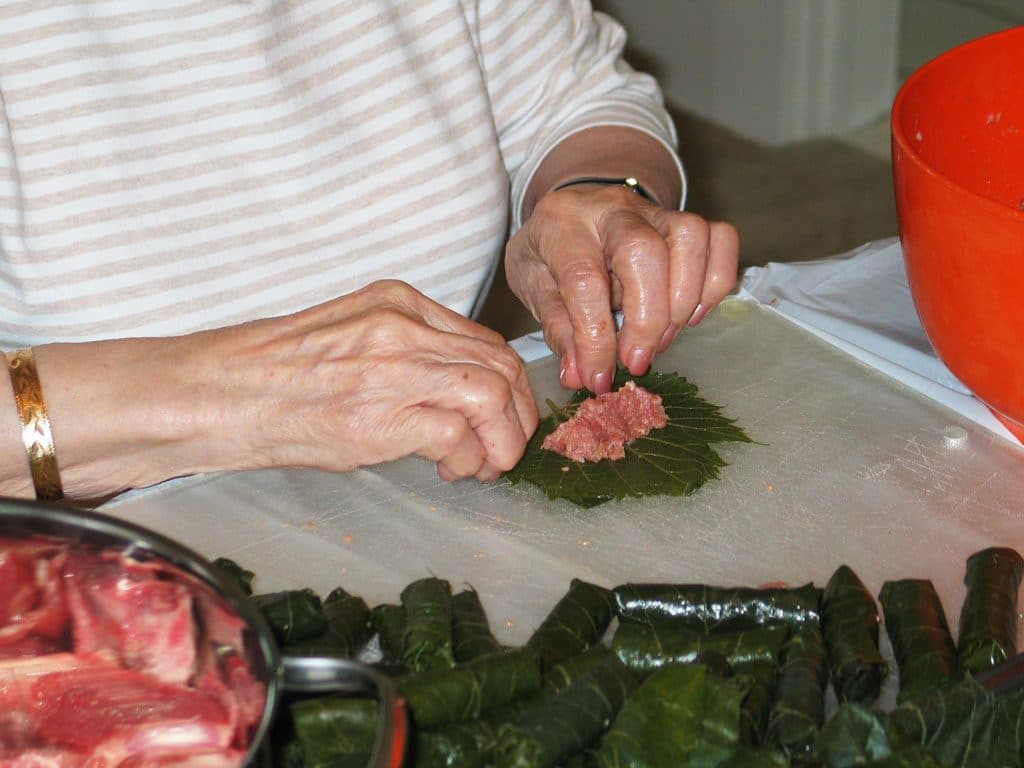
How do you make Lebanese Grape Leave Rolls?
Here are the steps to make excellent homemade grape leaves:
Step 1: Make the Filling
Rinse the rice. Add salt, pepper, cinnamon, and melted butter to the rice. Mix the rice with the ground beef or lamb thoroughly (hands help here!).
Step 2: Prepare the leaves
For jarred leaves: the leaves are packed tightly in the jar in a few bundles. Pour the liquid from the jar and discard it. Carefully remove the bundles of leaves. Place the leaves in a big bowl of cool or tepid water and agitate them to rinse and soak them. Repeat this twice, pouring off the water entirely after the second rinse.
For fresh picked or frozen fresh leaves: Place the leaves, fresh or frozen, in a large bowl or pot of boiling water. Blanche, gently cooking the grape leaves for 5 minutes to soften them. Fresh leaves roll more easily and stay closed if they are softer from cooking.
Cut the stems. Either stack the leaves in bunches all in the same direction or lay them out individually on the countertop or work surface. Use scissors to trim off the short stems all the way to the edge of each leaf.
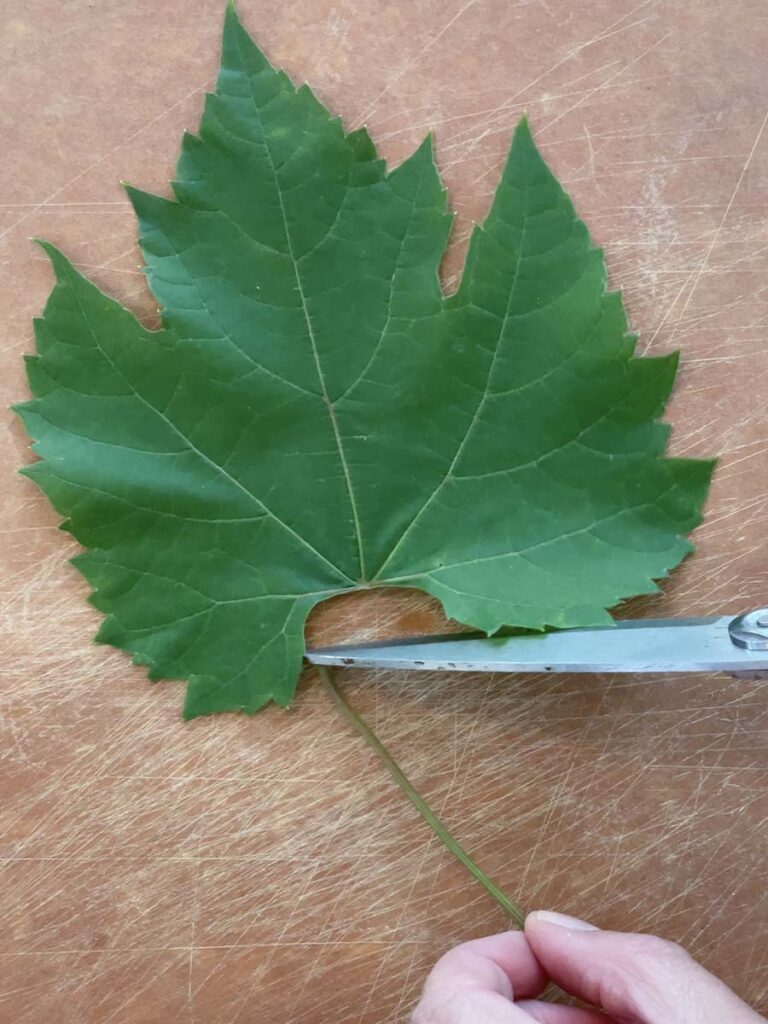
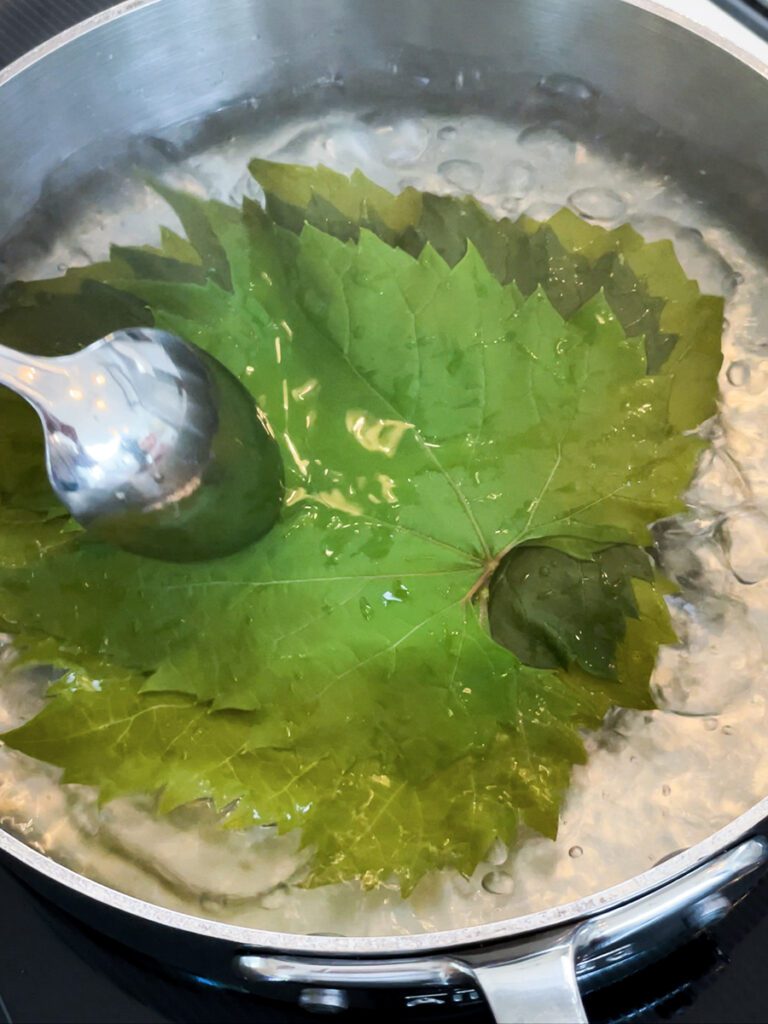
Step 3: Prepare the cooking pot
Use a 4-6 quart heavy pot. Line the bottom of the pot with pieces of chicken (legs, thighs, anything bone-in), bone-in pork chops or lamb chops. Lay any torn grape leaves or just a few of the largest leaves over the top of the chicken layer.
Step 4. Roll the grape leaves
See the photos below picturing the following steps for how to roll grape leaves:
Lay multiple leaves out on a flat surface with the vein side facing up so the veins end up inside the roll. The stem end should face you.
Use about 1 teaspoon of the filling per leaf, give or take depending on the size of the leaf. This may seem like very little filling, but this is all you need for a cigar-sized roll. Shape the filling across the stem end of the leaf in a log, leaving enough leaf on either side of the meat for folding.
Don’t roll the leaves too tightly—allow room for the rice filling to expand, which it will during cooking.
Fold each side of the leaf over the meat like an envelope. Roll securely, away from you. Tuck any leaf points into the fold as you go.
End with the tip of the leaf facing down.
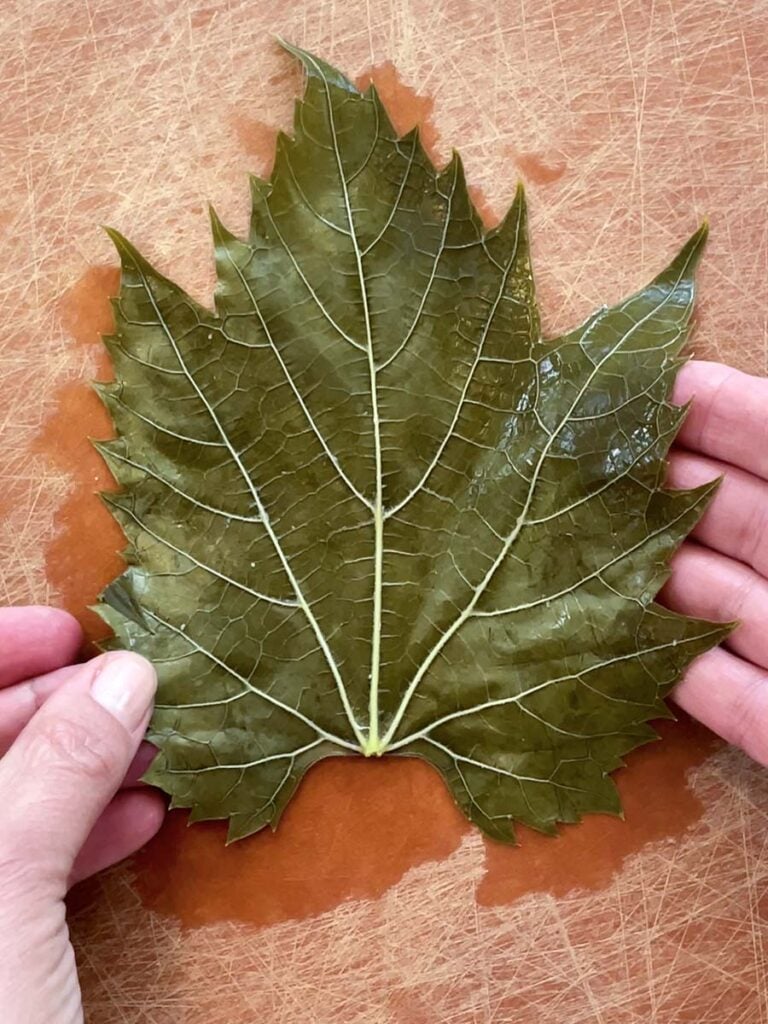
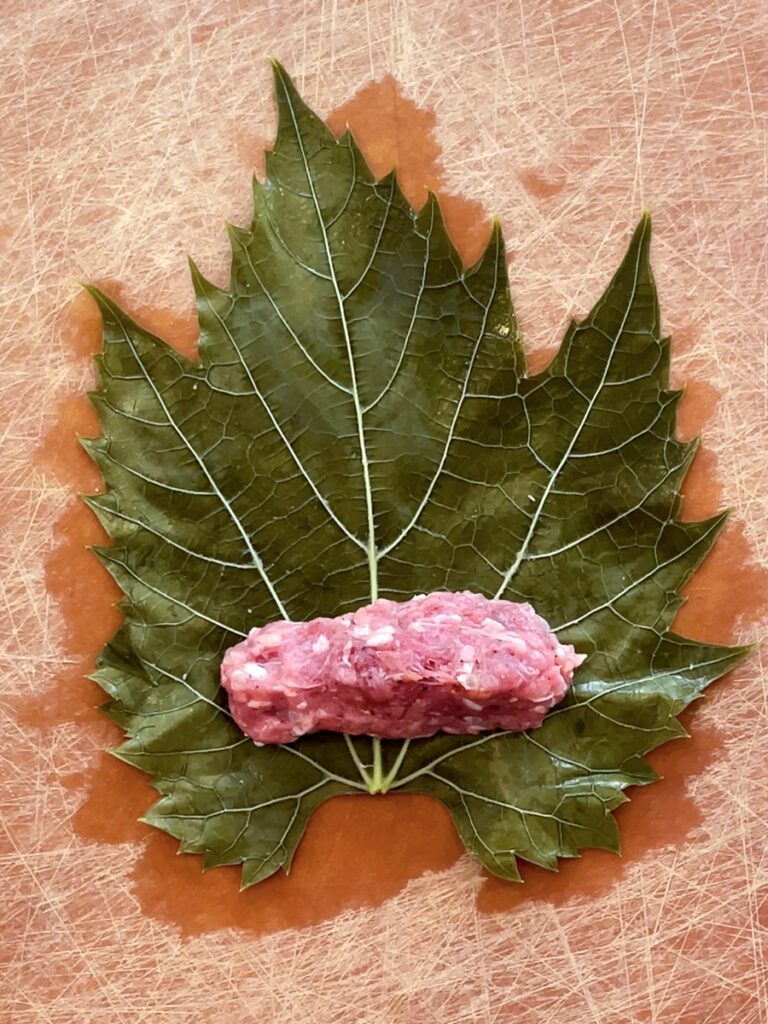
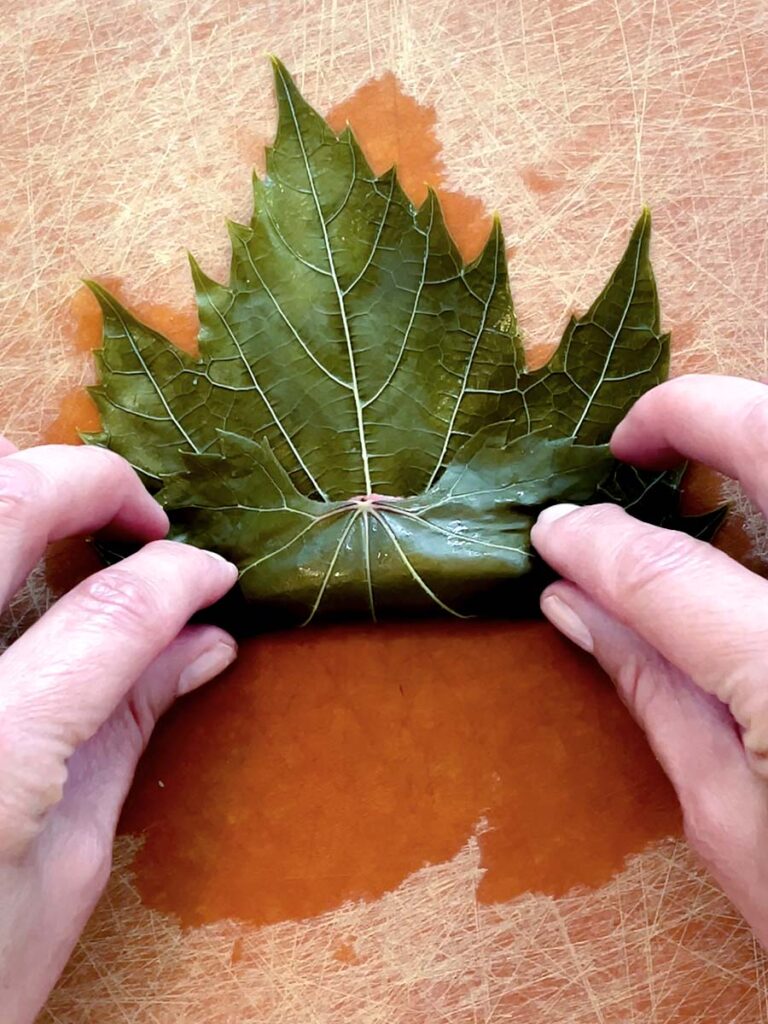

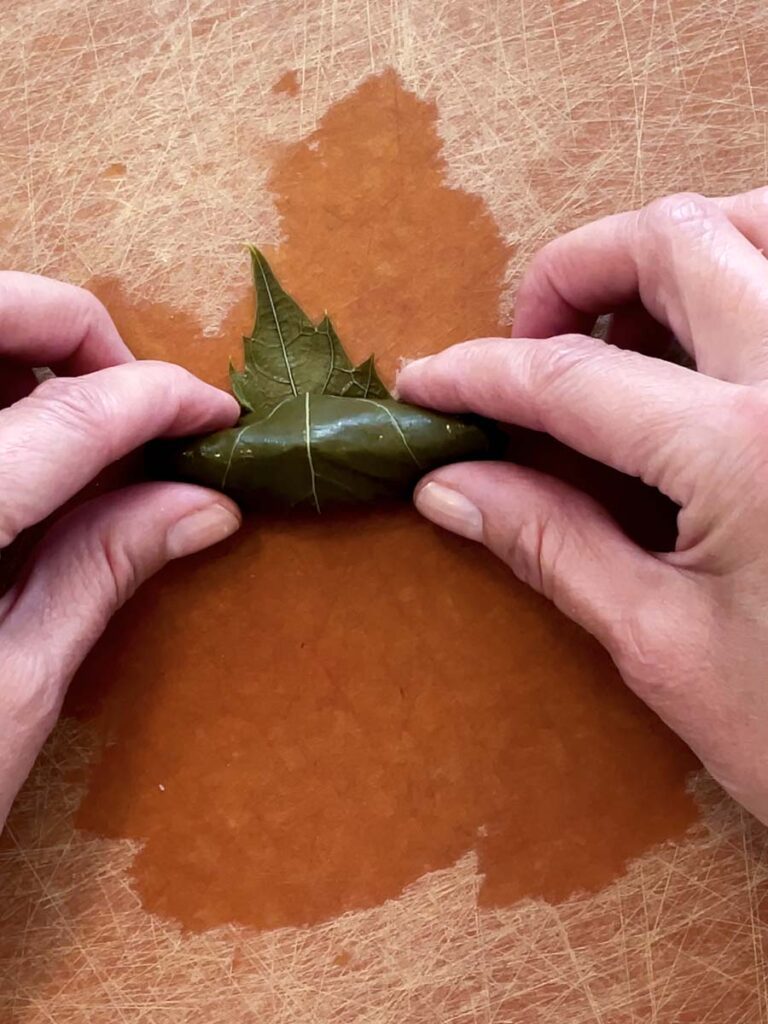
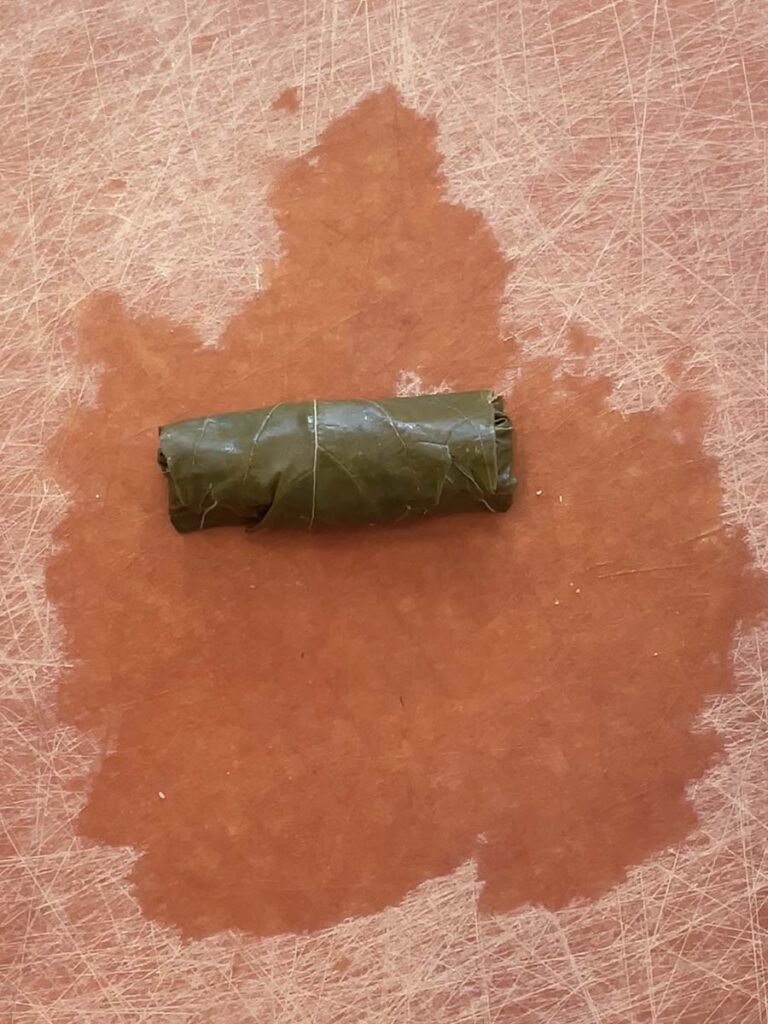
Step 5. Fill the pot with rolls, broth, and lemon juice. Cook!
Arrange stuffed leaves in rows in the prepared pan, alternating the direction of each layer of rows. Place a small plate face down over the top layer to prevent the rolls from floating.
Fill pot with a mixture of chicken broth and lemon juice up to the plate. Cover and bring slowly to a boil over medium heat. Reduce the heat to low and cook on a gentle simmer for another 60-90 minutes, until rice and leaves are tender and most of the liquid is absorbed (there will be some liquid remaining after cooking).
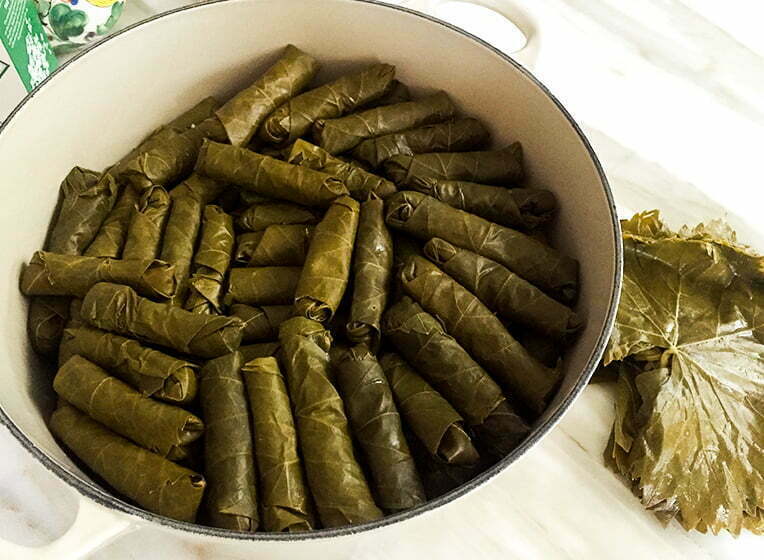
Step 6. Cool!
It is not easy to wait until these juicy, mouthwatering bundles of love are cooled off to eat! But:
Lebanese grape leave rolls are meltingly soft while still hot! So that they don’t fall apart as you remove them from the pot, allow the rolls to cool with the lid off the pot for at least 30 minutes before serving.
Step 7. Plate and serve
Serve grape leaves one of three ways:
- Serve directly from the pot, using tongs to pull each roll from the pot.
- Flip the entire pot of rolls into a wide bowl by placing the bowl over top of the pot, then flip over quickly (and carefully!). Make sure to pour off the excess cooking liquid before flipping the pot. Remove the meat layer and serve that on the side or discard (it’s not pretty!).
- Place the rolls on a serving platter, using tongs to transfer the rolls from the pot to the serving platter.

Important Tips for Making the Best Lebanese Grape Leave Rolls.
- Rinse the uncooked rice. This quick step helps rinse off excess starch from the rice, contributing to a soft-yet-firm grape leaf roll texture.
- Try to roll the leaves all about the same size. This means using the same amount of filling in each, and not too much! Also, if a leaf is very large, try cutting it in half and working with it that way. If a leaf is very small, use that one and the very large or torn leaves to line the bottom of the pan.
- Be sure to place an inverted plate over the rolls and broth. This step is key to keeping the rolls securely in place so they don’t float and unravel as they cook. Use an old plate if you like; I use a salad plate from every day dishes and the plate cleans up back to normal afterwards, no problem.
- Beware of adding lemon wedges to the pot. I always used to add slices of lemon throughout the pot of rolls, but I discovered that the lemon rind can add a bitter taste to the finished rolls. Now I use lemon juice only, not the lemons, to season the rolls.
- Cool the pot of rolls before transferring them to a serving dish. They are very soft when hot right after cooking. Once they cool off a bit, they hold their shape and can be served easily without breaking apart.
Can I make them ahead of time?
To make grape leaves in advance, there are a couple of ways:
Refrigerate:
- Refrigerated, cooked, for up to 3 days. Cook them, cool, then refrigerate in the cooking pot for simple reheating on the stovetop. To reheat from another oven-safe container, add some lemon juice, cover, and warm in a low oven until heated through.
Freeze:
- Cooked grape leaves can be frozen in an airtight container or ziplock bag. Thaw them in the refrigerator, then warm them in the microwave or oven, covered and spritzed with lemon juice or chicken broth, before serving.
- Raw rolled grape leaves freeze well in a plastic airtight container such as a Rubbermaid container with a lid. Layer the rolls in the container and use wax paper between the layers. They will hold in the freezer for up to 3 months. To cook, transfer the frozen rolls one at a time to the prepared pan and proceed with the recipe from there. Increase initial heat and cooktime on the stove to get them boiling, then simmer on medium low heat for 90 minutes to 2 hours.
Are stuffed grape leaves really Greek or Lebanese?
Many cultures of the Mediterranean make grape leaves! Greeks, Turks, Persians, and many more.
Greeks call them dolmades and typically serve the rolls with avgolemono sauce, a lemony egg sauce that is very delicious!
Lebanese call grape leaves warak enab, which is Arabic for, you guessed it!, grape leaves.
If you love Greek food, you should try this spanakopita recipe!
Frequently Asked Questions.
They sure are: Green leaves and lean meat are a winning combination that is also gluten-free. Grape leaves can also be made vegan.
Ohhh the heaven! Lemon is a primary flavor that shines brightly in grape leaves. Cinnamon and the ground beef or lamb is traditional and does not taste like cinnamon per se; this is a flavor that simply enhances the taste of the meat.
Both, my friends, both! And many other cultures enjoy their own versions of grape leaves. See my note above here about this.
Jarred leaves can be found in Middle Eastern and Mediterranean grocery stores. Depending on where you live, some of the big grocery stores like Kroger or Publix also carry them too.
To pick fresh, you must find edible grape leaves which come from wild vines. These vines do not bear big clusters of grapes like wine and eating grape vines do. Follow my guide and my video on how to identify, pick, and store fresh grape leaves here.
Love vegetarian stuffed grape leaves (they’re also vegan)! Try my recipe!
I’m happy to report that yes, frozen cooked grape leaves can be reheated to their original delicious state! I used to do this for my nephew John, freezing grape leaves in packs of 6 each in a small freezer bag that I could refrigerate and thaw overnight and then put in his lunch. By lunch time they were just right at room temperature! This is how to thaw frozen grape leaves, in the refrigerator overnight, then warm to room temperature or reheat in the microwave or oven, spritzed with water or lemon juice and a drizzle of olive oil to refresh the leaves.
I’m glad you asked because, yes, grape leave rolls are gluten-free!
Make Ahead: how to store grape leaves
Lebanese grape leaves take some time to prepare (and it’s so much fun!). Thankfully most if not all of the process are easy to make ahead. My mother-in-law always made her grape leaves about 4 days in advance of any feast. Follow the recipe all the way to placing the plate on top of the leaves. Refrigerate, covered. When ready to cook, add the broth and lemon juice and proceed.
To cook grape leaves in advance, simply cool the pot of rolls, then cover and refrigerate for up to 5 days. Reheat on the stove over low heat. Or, plate the grape leaves and reheat in the microwave or oven. Coat the rolls with some lemon juice and olive oil to revive the leaves before (and after) reheating.
To store leftover grape leaves, place them in an airtight container in the refrigerator for up to 5 days. Reheat as noted above.
What do you serve with Lebanese Stuffed Grape Leaves?
Lebanese grape leaves are traditionally served as part of mezze, small plates of appetizers. They are beautiful on this Lebanese Mezze Platter. We also eat them as one of many dishes for a main course as part of a meal.
Grape leaves are delicious with labneh, a dollop over the top or thinned out a bit with water or lemon juice, as a dipping sauce.
Serve stuffed grape leaves with flatbread and olives too.
It seems that whenever we have grape leaves, we also make:
Smooth, Creamy Homemade Hummus
More Lebanese Recipes to Try:
Lebanese Cabbage Rolls are another rolled favorite, with the sweetness of cabbage.
Chicken Shish Tawook, grilled chicken skewers are moist and tender.
Grilled Beef Kafta Skewers are a favorite with highly seasoned kafta meat.
Easy Chicken Shawarma marinates chicken thighs and grills them to shawarma perfection.
Mujadara, lentil and rice pilaf is a wonderful protein and fiber rich vegetarian dish.
How to make Yogurt, from which you can thicken yogurt into labneh!
Pan Seared Lamb Chops make succulent chops, stove-top.

Lebanese Stuffed Grape Leaves Recipe (Warak Enab)
Ingredients
- 1 cup medium grain rice
- 4 oz. (1/2 cup or 1 stick) salted butter, melted
- 1 tablespoon kosher salt, plus more as needed for the cooking liquid
- 1/4 teaspoon freshly ground black pepper
- 1/2 teaspoon cinnamon
- 1 pound ground lamb or beef (80% lean)
- 80 grape leaves, medium size, from a jar or fresh
- 6 chicken wings or thighs or 3-4 bone-in pork chops
- 3 cups chicken broth or water
- 1 cup freshly squeezed lemon juice, from about 6 lemons
Instructions
- Make the Filling: Rinse the rice. Add the salt, pepper, cinnamon, and melted butter to the rice. Mix the rice with the ground beef or lamb thoroughly, using your hands to combine.
- Prepare the leaves. For jarred leaves: the leaves are packed tightly in the jar in a few bundles. Pour the liquid from the jar and discard it. Carefully remove the bundles of leaves. Place the leaves in a big bowl of cool or tepid water and agitate them to rinse and soak them. Repeat this twice, pouring off the water entirely after the second rinse.For fresh picked or frozen fresh leaves: Place the leaves in a large bowl or pot of boiling water. Blanche, gently cooking the leaves for 5 minutes to soften them. Fresh leaves roll more easily and stay closed better if they are softer from cooking.
- Trim the stems. Either stack the leaves in bunches all in the same direction or lay them out individually on the countertop or work surface. Use scissors to trim off the short stems all the way to (but not beyond) the edge of each leaf.
- Prepare a 4 or 6 quart heavy pot. Line the bottom of the pot with the chicken or pork. Lay any torn grape leaves or just a few of the largest leaves over the top of the meat.
- Roll the grape leaves. Lay multiple leaves out on the work surface with the vein side facing up so the veins end up inside the roll. The stem end should face you. Use about 1 teaspoon of the filling per leaf, give or take depending on the size of the leaf. This may seem like very little filling, but this is all you need for a cigar-sized roll. Shape the filling across the stem end of the leaf in a log, leaving enough leaf on either side of the meat for folding.Don’t roll the leaves too tightly—allow room for the rice filling to expand, which it will during cooking.Fold each side of the leaf over the meat like an envelope. Roll securely, away from you. Tuck any leaf points into the fold as you go. End with the tip of the leaf facing down.
- Fill the pot with rolls by arranging them seam-side down in rows in the prepared pan. Alternate the direction of the rows with each layer of stuffed leaves. Place a plate face down over the top layer to prevent the rolls from floating.Fill the pot with a mixture of the chicken broth and lemon juice up to the plate. If using water instead of broth, or if using unsalted broth, add a tablespoon of kosher salt (half that if using table salt) to the liquid before adding to the pot.
- Cook the grape leave rolls. Cover the pot and bring slowly to a boil over medium heat. Reduce the heat to low and simmer for another 60-90 minutes, until the rice and leaves are tender and most of the liquid is absorbed (there will be some liquid remaining after cooking).
- Cool. Allow the rolls to cool with the lid off the pot for about 30 minutes before serving.
- Serve the grape leaves one of these ways:1. Serve directly from the pot, using tongs to pull each roll from the pot. 2. Place the rolls on a serving platter, using tongs to transfer the rolls from the pot to the serving platter.3. This is more of an experienced-makers method: Flip the entire pot of rolls into a wide bowl by placing the bowl over top of the pot, then flip over quickly (and carefully!). Make sure to pour off the excess cooking liquid before flipping the pot. Remove the meat layer and serve that on the side or discard.
Video
Notes
- Try to roll the leaves all about the same size. This means using the same amount of filling in each, and not too much! Also, if a leaf is very large, try cutting it in half and working with it that way. If a leaf is very small, use that one and the very large or torn leaves to line the bottom of the pan.
- Be sure to place the plate over the rolls and broth. This step is key to keeping the rolls securely in place so they don’t float and unravel as they cook. Use an old plate if you like; I use a salad plate from every day dishes and the plate cleans up back to normal afterwards, no problem.
- Beware of adding lemon wedges to the pot. I always used to add slices of lemon throughout the pot of rolls, but I discovered that the lemon rind can add a bitter taste to the finished rolls. Now I use lemon juice only, not the lemons, to season the rolls.
- Cool the pot of rolls before transferring them to a serving dish. They are very soft when hot right after cooking. Once they cool off a bit, they hold their shape and can be served easily without breaking apart.
- Would you like to pick fresh grape leaves? Yes! Follow my guide here and check out my video here to identify and store fresh grape leaves.
Nutrition information is automatically calculated, so should only be used as an approximation.

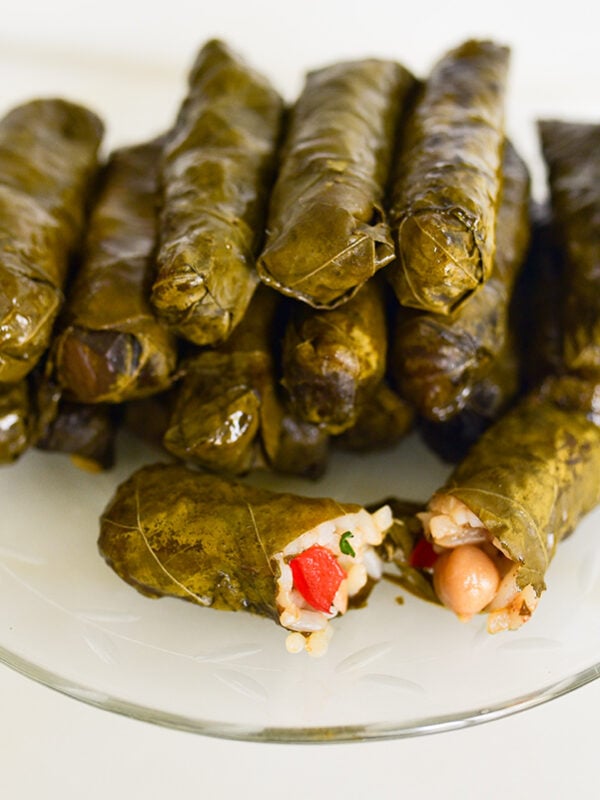








Hello,
I saw that you froze them in tupperware with waxed paper. Did you do this before cooking them or after cooking (and then just reheating them). Which is the better way? I only need to freeze them for a few days. Thank you.
Hi Tracey, I freeze them before cooking in layers like that. It works beautifully. I have also frozen and reheated cooked grape leaves, but I generally do that with leftovers rather than the first cooking.
Stuffed Grape Leaves…my favorite. I always joke with my family that stuffed grape leaves will be my last meal before I go to the electric chair!
THE BEST, first and last!!!
My mother’s family are from Palestine and I grew up eating these dishes. I make alot of them myself. Your recipes are almost exact to what I was taught,even down to the little extra tips you publish with your recipes. Thank you so much for sharing your recipes and your heritage. I am so glad I found your site. Denise Townsend
Denise waht a beautiful note, thank you so very much. And welcome here!
Thank you so much for the grape leaves brand tip, Maureen. I’ve heard of Orlando before but we do not have this brand readily available in Toronto. I looked online and didn’t feel like spending $62 on a jar of grape leaves off of Amazon (haha, I’m not even kidding). I’m happy to say that your tip about Yergat yielded positive results! A nearby middle eastern store sells them, only 10 minutes away! I used to use a readily available brand here, but the leaves were often quite tough. I’m excited to try Yergat! Thank you!
Thanks so much Christina–whoa what a crazy price! I’m so glad Yergot worked great for you.
I do have a Lebanese cook book, but your receipt is so much tastier !!. thank you so much !
Thanks so very much John!
THANK YOU. It’s been a long time since I’ve made these delicious recipes. I’ve since suffered a traumatic brain injury. Thanks for sharing your videos of how to make your fabulous creations‼️ And above all, THANK YOU for being so generous and gracious in sharing your wonderful recipes with us‼️ Sending you and your family lots of love and thanks❣️
God bless you Joyce! I’m thrilled to be connected! Keep me posted on your cooking and may you continue to heal and enjoy all of life!
I LOVE this recipe. My mother is Lebanese and I grew up making her recipe/Madlain Farah’s which is all of maybe 8 lines of instructions. This is always such a helpful reminder before I sit down to roll. Also, the butter? Amazing. I haven’t quite revealed that secret ingredient to my family yet but it certainly elevates this dish! Thank you so much for this authentically Lebanese recipe! You’ve got me excited making this dish again.
<3
That’s so great Madeleine! Right, the butter?! Thank you!
Love your recipes‼️
Love your recipes‼️
Thank you!
Love this! You cook like my family does in Oklahoma!
Love that Gina cousin!!!
Delicious!! Thank you!
Thank you Laura!
Hi Maureen! We frequently used to have these without meat. How do I alter the recipe to make it these without meat? Would I need to double the rice and butter mixture to account for the missing meat?
Hi Becci! Oh yes, we love them vegetarian-style too. Check out Vegetarian Grape Leaves and see what you think.
Just giving this recipe 5 stars right now because of how detailed it is with all the helpful tips! I’ve never made these before but I’m planning on doing it soon for my Lebanese bf.
I was wondering… Do these freeze well? We’re only two people with lots of vegetarian friends, and I want to make the meat version like his grandpa used to!
Jehrin I’m thrilled, thank you! YES, they freeze really really well. Last Thanksgiving I test freezing them in plastic tupperware-style boxes in layers with wax paper between them. I cooked them from frozen, placing the frozen rolls individually into the pan as usual, and covering with broth/lemon/water from there. Excellent!!
I grew up eating Lebanese dishes made by my mom (Venezuelan-Lebanese) and other Lebanese cousins. I used to make them without measuring the ingrediensts, which is contrary to my chemist mind. However, since I found your recipes I use them with the best results, always getting great praise. Thank you, thank you, thank you.
Margie that is just an honor to hear and makes me very very happy! Thank you! I’m so glad we share this beautiful heritage.
Hi Thankyou for this recipe I’ve tried it but when I bit into the leaves it turned out the rice was raw now I’ve put it all back in the pot hoping if I cook it further it will be done fingers crossed what do u think went wrong
Nakia oh no! It sounds like they didn’t cook long enough. Bring to boil slowly and then cook for 90 minutes. I like to taste one before taking them out of the pot to be sure it’s fully cooked. It’s also helpful to allow the grape leave rolls to rest before removing them from the pan.
I’m your 95 yr old fan who will celebrate my birthday tomorrow and made a pot of grape leaves today for the family who will drop in this weekend. I marvel how similar your recipes are to mine which I got from my mother. I really enjoy all your recipes and stories which I can relate to. I have even gotten new ideas which is rare at my age. Thank you
Vee! You tickle me!! And touch me. What a joy and a blessing you are to your family. Happy happy birthday to you, sending a big hug from here. Please keep in touch!
These are delicious! My mom made these often and we helped to roll them as we got older. I did get a few tips also.
SO delicious! And such a special tradition that we need to keep alive. Thanks so much Cris.
All grape leaves are edible! So are the young shoots and tendrils..in fact, many of the “bunch table grapes” have superior sizes and shapes to many jarred varieties, so, if you have grapes growing, go for it! I’ve also found every stuffed vine leaf version to be pleasing, but, the 50 50 beef lamb, with added tomato sauce either inside or to the simmer broth plus lots and lots of spices, fresh and dried mint, browned onions and garlic to be the best! I found a baked Persian version that had added sugar and lime juice that was super tasty too..
Hi there–thank you for your grape leaves knowledge! And your recipe suggestions too, delicious!
Maureen, this beautiful post made me cry. Looking at the pictures of your relatives puts me in mind of my Sittee. She had that Lebanese look: the heavy brows, the curl-wavy hair, the big eyes, the distinct tilt of the nose and cheeks. And above all, the radiant happiness, generosity, and puckish sense of humor that shone in every interaction. Your post made me remember her and the summer afternoons my cousins and I would spend picking grape leaves for her — she paid us 1 cent per leaf!
Andrea…thanks so very much, what a beautiful note and a beautiful Sittee. Blessings indeed.
I do not eat meat but I love stuffed grape leaves. Instead I use garbanzo beans, lots of parsley, onions, salt pepper, rice not cooked, olive oil, freshly squezed lemon. Steam the dish in water , oo and lemon juice to cover the bottom of the pot. I put extra grape leaves on the bottom of the pot as well. High heat till the water starts to boil, reduce heat. With laban, what else do you need. I llove your recipes and stories reminds me when I spent summers with my situ. Thanks you.
That’s a beautiful recipe Norma! Similar to one I make, very delicious and I don’t miss the meat! Thank you for your kind words, our memories are as special as our food and the two are interconnected in a deep way.
My favorite memories is of walking into my situ’s house and seeing both a large pot of warak enab and mujadara, and fresh Manakish.! Thank you for evoking it again for me!
Beautiful!
Yes, tears of many varieties especially after the devastating news of yesterday. I’m so glad you were able to make this trip. We had to cancel ours in May due to the pandemic.
xo
Carol
Maureen,
Look at how many hearts you touch both through your words and amazing recipes/products!!!
I put sliced potatoes on the bottom of my pan to keep the grape leaves from sticking. The potatoes are sooooo yummy to eat. (Worth fighting over to eat!)
I have the perfect stone wall in my backyard to grow a grape vine. You inspire me to figure out how to make that happen.
I’ve never been to Lebanon, and probably will never have the opportunity. I deeply treasure what you share…thank you.
Kebra
Oh Kebra, how kind and special. Thank you so much. We are kindred spirits.
I love seeing how the fillings of the grape leaves reflect family food tradition’s and (assuming) regional foods. I’ve been rolling and making them since I was a young girl. Learned from my parents. Our ingredients are: meat, rice, crushed garlic, cinnamon and mint, crushed tomatoes for added moisture to the mix. We also included a lamb shank or chop at the bottom of the pan and lined with lemons. So good. Just made some for New Year’s Eve to share w/ friends. Also made for my daughter in S. Carolina for Thanksgiving and found the best grape leaves – Raureni. Unfortunately, they’re not available in DFW (just San Antonio and Austin). Worth checking out.
It’s always a joy to cook your recipes. Continued success to you in 2020.
Jeannine
Jeannine, your ingredients with the garlic and mint and tomatoes sounds divine. I’m going to try it. I love that you are making the grapeleaves for your family and dear friends! Lucky people. Great to know about Raureni, which I’ll be looking for…. Thanks so much and blessed new year to you and yours!
Maureen,
Our family recipe calls for allspice, not cinnamon. I don’t see this in any other recipes I’ve looked at? They also used canned tomatoes (hand crushed) and a bit of tomato sauce in the filling. I don’t see this either usually. I’m always worried to change it up…
Feedback?
Hi Janice! My family recipe also calls for crushed tomatoes and tomato sauce in the filling. I can’t imagine yebret (that’s what my family calls them) without tomatoes! I didn’t realize that tomatoes weren’t a standard ingredient until I looked at this recipe and a recipe in another cookbook.
Hi Maureen
I am Lebanese and Lebanese food is my all time favorite foods! I never learned how to cook from my Tita, but I have decided now that I have grown children, I want to learn. I want to share my heritage with any grandchildren I may have and also inspire my daughters to learn.
I noticed in the video you use chicken stock and the recipe has water. How much chicken stock is used? How much lemon juice?
Thank you
Hi Laura–thanks so much for this question. I now use a good cup or more of lemon juice to cook the grapeleaves, and the rest is chicken stock. I’ll mix the lemon juice with stock in a 4-cup measure and then add additional stock if needed to fill the pot. Keep cooking and learning and sharing–it’s such a blessing!!
So happy for you D. Pokonosky. As a personal note my grandmother was from Aleppo my grandfather from Damascus, Syria.. I inherited their stuffed grape leaves recipe, and because of my grapevine, I make so many during the summer and freeze the leaves for the winter here in the Northeast. So grateful and proud of my heritage.
Amen Paula, thanks for sharing! And lucky you, with that recipe and vine!
JUST CAME BACK FROM A TRIP TO LEBANON WHICH WAS AWESOME, SAFE AND ON MY BUCKET LIST FOR YEARS…………….SAFE AND MORE THAN I HOPED FOR . WENT WITH A TOUR FROM THE LEBANESE/SYRIAN FEDERATION,,,,,,,,,, DOROTHY
Wonderful Dorothy!
Thank you. Thanksgiving was always a mix of traditional Lebanese and American dishes with my dad’s side of the family. It doesn’t feel like the holidays without wariq 3ainab! Now that I live out of U.S. and far away from most of my family, keeping this tradition going means even more. I adore the stories and recipes here; thank you again for sharing.
Thanks so much Rachel!
I wasn’t sure how/where to leave a comment but I bumbled my way to an opportunity so I’m taking it. I’m sure I fit in here like a purple and pink tiger being half Scandinavian and half Polish but why not. I am expanding my ethnic horizons around the things I choose with which to nourish my body and these not only sound yummy and look like fun to prepare, but I am presently standing on the middle of a Minnesota State Forest with a box of fresh picked Wild Riverbank Grapes. I will have to wait 9 months but I guarantee you that I will not forget to start utilizing this amazing plant much earlier in the season from here forward. Can I put Lutefisk in there. J/K I have no interest in trying that anchor to my ancestry.
James you sure do fit here!! What a great note!! I can’t wait to hear about your stuffed grape leaves from your own vines!
I love your writing and your recipes!
Just to be clear, in your stuffing recipes (book and blog), the ground meat and the rice are *not* cooked prior to stuffing, but cookin the course of he simmering?
Thanks for sharing!
Thanks Erika! Yes, the stuffing is raw, cooked as it’s simmered!
Dear Maureen
I would like to share with you a much simpler method for preserving the leaves. I cut them fresh, stuff them in an empty 2-litre water plastic bottle, partially suck the air out and at the same time slightly crush the bottle to aid in emptying the air and quickly close it.
The leaves keep their taste for years!! When needed, I cut open the plastic bottle with scissors or knif, wask the leaves and use them as normal.
Maureen,
Thank you for sharing this story. Just stumbled upon it through google and am now obsessed with your blog. My family has had a Christmas time tradition of making grape leaves and Shish Barak since I was born (27 years ago). We actually your very small cuts of lamb (little fingernail size) instead of ground lamb. Although it requires much more effort, the tenderness of the lamb makes it worth it!
Thanks again
-Adam
Wonderful Adam, thank you for sharing!
Maureen,
Thank you so much for sharing, I stumbled on your blog from a google search, and I bookmarked it and refer to it. I left Lebanon 25 years ago, but Lebanon didn’t leave me. I am always looking at recipes of dishes I use to enjoy back home to share with my family. Your blog is what I was looking for. I love the stories and recipes and the connection. Since I have relatives from Deir Mimas, this story caught my eye. I am walking to the kitchen to start cooking, grape leaves, Mujaddara (lentil and rice dish), as well as vegetarian green beans stew (lobbied bi zeit). Again, thank you for sharing.
-Labib
Beautiful Labib, thank you so much!
Hi, is the 1 cup of long grain rice supposed to be cooked when you roll it in the leaves?
Hi Liz–that’s uncooked rice. Enjoy your grape leaves!
Nice story. I loved reading this story, brings me right back to when I was a youngster ad on rainy days in the kitchen making this dish as well as other platters. So invigorating and makes me hungry for these.
That’s beautiful, thank you!
My Beautiful family from Latakia use lamb mince, long grain rice, allspice and salt&pepper, garlic optionally a little finely chopped parsley and mint and you can add onion very very finely diced for extra flavour.. We saute ingredients with mince in samneh (ghee) or butter until the meat is browned then we let it cool( this is our filling) once cooled we stuff and roll the vine leaves which would be fresh blanched in salt water or prepared brined out of jar … We then put sear a few lamb shanks or neck or any lamb bone cuts.. Put a few to line bottom of a large pot.. Then place and stack stuffed leaves around the pot like a circle starting from outside toward in.. Placing a few whole garlic bulbs in the skin throughout ( this adds flavor and tastes fabulous when ready to serve) melting in ur mouth) then once u reach close to the top ( leaving room for a few more lamb bones) we place a few more lamb bone cuts on top… And cover with desired amount of lemon juice and water to cover then place a plate to keep in place and lid of pan.. Get temperature to the boil then put on low temp for 2-3 hrs.. Until rice in rolls is cooked .. Then serve squeezing a bit more lemon juice…Laban ( yoghurt) fresh Arabic bread and a salad ( tabbouleh) is great! 😉 you can alternatively stuff with a bourghol and herb mix or the above mix minus the meat.. Enjoy. Help the Syrian people during their sad and disastrous
crisis.. And find a well known sponsor/ organisation to support and donate to for our people;) remember Allah kareem .. 😉
Thank you for this…I made these for the first time in many years…I was just a wee one….
How special Valerie!
Hi Maureen, I just read the Saveur Best Food Blog Awards. Congratulations. I’ve been planning on making Stuffed Grape leaves as I was driving yesterday, and after reading your blog decided that I must this week!
I don’t have fresh leaves or even my favorite brand(Orlando).Ihave been taught by my Tita and Dad how to roll them. Grandma likes them too small compared to my father’s instructions. A little more filling. I have not tried a lamb or goat bone yet. I noticed no tomatoes(sliced on top instead of lemons). peeled garlic cloves to pack around the rolls, or cumin. 1/2 cup of lemon juice in the water makes it perfect for me. My wife, Fabiola and I love to eat the grape leaves that are from the bottom of the pot. I also like the tomatoes. I miss those times sitting down with dad(Rami),Grandma(Nadia) and my brother and sister(Brook and Nadia). Thanks again for Your sharing, Sean
Wonderful Sean–I love hearing about your family and their way in the kitchen! Thank you, and enjoy the grape leaves!
I recently purchased stuffed grape leaves (meatless) they were great. I make my own, however these (purchased) I was told has fresh tomatoes, any one know how to make these? thank you
Thanks Linda–the meatless are delicious and can be made a variety of ways. Here’s my recipe, which includes fresh tomatoes:
Hi Maureen,
I don’t know where to start, talking about your touchy story or your wonderful grape leaves recipe,
however, i think you are one of the most Lebanese great story teller and cook.
I truely enjoyed your stories and your ways of preparing Lebanese food. you are one of the kind women who has a great soul and great love of our culture and heritage.
I told you in the pass that i do cook for my family and enjoy the creation of food from scratch. I think when we take the time to create a meal for our beloved ones, it gives us the peace of mind that our children are well fed there fore they will be strong.
last time i visited Lebanon was 20 years ago, I went to Baalbeck my home town and to byblos my fother’s home town and spent couple weeks in Beirut at my sister’s house. I enjoyed two dishes in Lebanon, one was simple Falafel and the second one was Samaki harra (spicy fish).
I was wondering if you have a recipe for Spicy fish the Lebanese way, i would appreciated.
I wish you the best and wish one day to meet you as I said in my last email to you.
Samy
Samy, that is beautiful and I thank you for your wonderful words. I have a pan-seared snapper that is similar to the spicy fish in Lebanon–see it here:
Loved your story. Have a similar one when my husband and I visited Sydney Australia to meet the children of my mother’s half brother. He was left in Lebanon as a child when his father died and mother had no where else to go as he was considered property of the husband’s family. She came to the U.S. and had two little girls, dying when they were very young. She never saw her son again, he never saw his mother and my mother and her sister never met their brother. When our families found each other my mother and their father had passed. When I stepped off of the plane, 100 years of longing were fulfilled. I met loving cousins and saw in them the faces of my past. I can only assume that my mother and her brother had a hand in this once they were together in heaven. We remain close and they have also travelled to Michigan for my daughter’s wedding. Our next journey is to go to Lebanon to see my family’s home. Thank you for sharing your memories.
That’s just amazing and so touching, Nora. We are kindred spirits then. Thank you for writing and please stay in touch.
Hi Maureen,
You need to be playing baseball; you just hit another homerun. Thank you for the great piece and recipies. Any information on the baby coosa? I’m still looking.
Regards,
Tom G.
Thank you Tom! That baby coosa question remains!
What about the baby cousa? I have a grandma I can ask 🙂 might be a late reply but maybe you are still wondering 🙂 have a good one
George! Were you looking for a recipe for pickled baby coosa, or where to buy some already made?
Hi Ms. Abood,
I’ve made this dish three times & each time my family says “it’s exactly like grandma’s.” You don’t know happy I am when I hear that because my mom passed away in 2000 & unfortunately I was not at all interested in learning to cook back then. I stumbled on this recipe one night when my sister wasn’t around & I wanted to attempt to make this. I kept thinking to myself no way! Like I’m really gonna find a recipe when I googled Lebanese stuffed grape leaves. Since then, I just wanna jump in my car & drive all the way to Michigan every time I read a new story or look at the postcards from Up North!! I love the stories & the pics. Keep them coming!!! Oh & the recipes are so easy to follow & delicious.
Regards,
Rania
Thank you so very much for your wonderful words, Rania! Your mama would be proud of you.
Dear Maureen,
I just found your website and I am in love with it.I am an American born Lebanese married to a Lebanese
born American.I love reading about your family.I was so glad to see that you make your stuffed grape leaves in lemon just as I do.I can’t find many people that do it that way.I have a large grape vine and am constantly stuffing leaves for my large family.I try to stuff as as many as my freezer will hold and then just freeze the leaves and then by adding a little extra olive oil they cook up delicious in the winter.My in-laws were from Kferksghab in North Lebanon and the love of food and family also binds us together.
Thanks so much Marion–your grape leaves sound wonderful!
Hi,
First, I really enjoy your site! I grow grapes in my backyard and wonder if anywhere on your site you mention how to jar leaves and if so do you specify as to which kind of leaves are best for jarring?
Regards,
Jeannette Khoury
Montreal, Canada
Thank you Jeanette! I haven’t jarred my own leaves (we always freeze them) but that’s a great idea…. The only leaves we use for this dish are wild grape leaves, not cultivated leaves from grapes (the wild ones don’t bear fruit).
Maureen, I had never never heard of wild grape leaves before my daughter married into a Syrian family.I grew up in a Lebanese community in Pa. and always had leaves from fruit bearing vines.When I make for my family I stuff about 800 to 900 each time.Then i try to freeze enough to make it a couple of times during the winter.I would never be able to have room to jar them.Just wanted to let you know I love your posts.
Wow, thank you Marion–I’m very interested to know this about your fruit-bearing vines and leaves!
hey Maureen. I like your post, and it’s a bit sad that you couldnt be able to go see our village DeirMimas. you know, we go there every 2 week-ends, and it is safe. I know that abroad the news projects a different image of the situation in Lebanon but it’s not as it seems.Hope next time you visit Lebanon, you don’t miss Deirmimas. And if I’ll be here we’ll go together.
I saw your picture in a magazine, Taste & Flavors, distributed in Beirut cooking Festival which I visited today. It’s a nice article about your blog and your Lebanese Cuisine.
my mother and i were guessing about your parents and grandparents. My mom is a Hourani, and my dad is a Toubia. take care. we’ll stay in touch.
Did you know this page is listed on the Deir Mimas facebook page?
Yes, so nice, thanks Roger!
Beautiful words. I hope you will be able to visit Deirmimas soon.
Stuffed grape leaves would be my dish of choice if I ever to be on a death row. How wonderful your story to show up around May 25th liberation day. My favorite thing to eat with grape leaves stuffed with meat is my homemade yogurt which also made it healthy aperture.
Maureen, your stories could be mine, and your formidable Aunts look just like my Aunts in Serbia, surrounded by hand-tatted doilies and beautiful pastries they share with their neighbors. Our paths are so similar and my visits overseas are always filled with anguish and tears, as much as joy and laughter. But I would not change that for anything:)
Influenced by the Orient, we also make these little rolls, but as we are land-locked, the preferred green is mostly sorrel. Throughout spring and summer months, this was a favorite meal of mine, and my girls continue the tradition, craving the rolls each year.
Thank you for your beautiful voice that brings me into your life as if I were a member of your family.
I don’t know if this is a big deal or not, but i nominated you for Food Stories Award. I hope the links work if you want to go and check out the site. https://foodstoriesblog.com/food-stories-award/ And here is my post about the awards: https://bibberche.com/2012/05/food-stories-award/
Have a great holiday weekend! Sending a big wave to Michigan, which was my first harbor when I landed on the U.S. soil. Ten years have left quite an impact and I still consider myself a Michigander in a way:)
Maureen, you brought tears to my eyes. God bless you.
Maureen you write so beautifully. I love reading your stories. God love you, you are so special. You make my day. much love, virginia
Thanks for sharing your stories… your blog always provides a nice break in my busy day. Very evocative writing.
And another winning recipe. I will make these for my kids… canned stuffed grape leaves and dolmas have been a guilty pleasure of ours for years. It’s time to upgrade to homemade.
Maureen,
Another beautiful story. Thank you.
Grape leaves are one of our family favorites. I learned to make them by helping my Dad and Mom roll them when I was a kid, and my children gathered around the kitchen counter and similarly learned from me. When my grandchiidren are old enough they will no doubt carry on. Try cooking them in chicken broth instead of water, especially if not using bones. This makes for a richer flavor. (My Dad taught me this.)
Hi …wonderful story…thank u so much for sharing …exactly how I make mine with the chicken broth …go good!!!!
………..Leslie
Maureen — Is that John’s beautiful hand? The boys just love the grapeleaves!! 🙂
Total agreement with all previous comments!! Beautiful, just beautiful…in so many ways!!!
Love, Jody
Actualy i ment i don’cry easily. Oh well
This story was beautiful. Both sets of my Grandparents came from Deir Meirmas. Almost made me cry which i do easily. Thank-you
Delightful story, thanks for sharing.
I will send this one off to my family tree list also, I am sure it will tug at their hearts as it did mine.
I too always wanted to visit Lebanon but my wife worries about safety.
But I am sure the present residents know where to and where not to go.
You made it back with your jar of grape leaves, so you were well taken care of.
A while back someone sent me an aerial shot of Blat, where our relatives came from, a small village nestled in the hills. Quite different than what you might imagine. I think that was the foreign equivalent of Google.
Our local expert in Wisconsin (Lebanese restaurant owner) likes his rolls very small with modest amounts of stuffing, pork and chicken boiled to get the stock, lemon on top at the end, all very good, yours looked wonderful also.
I like cabbage rolls too, made an inch thick and about 6 inches long, with a tomato juice cooking stock, we always got them before they were done, mom would complain but we maintained they were done (even though the rice was still crunchy).
Thanks Maureen much for your trip and stories.
Jerry
In Lebanon grape leaves are never ever stuffed with pork..it is either a vegetarian or meet mixture.
Just for the family stories alone, this blog entry is wonderful, but then you give us a recipe for the stuffed grape leaves, and you just about send me over the moon. I live in a very Greek neighborhood in NYC (locally, it used to be called “Little Athens”), so I’ve always had dolmades, and it’s one of my favorite dishes, from any type of cuisine, period. So now I am obligated to make your recipe!!! I cannot wait…
What a beautiful story. It also brought tears to my eyes. My mom took her mom to Lebanon many years ago. The pictures and stories were abundant. I have always wanted to go…maybe one year I will make the trip. It is on my bucket list. Thanks for sharing.